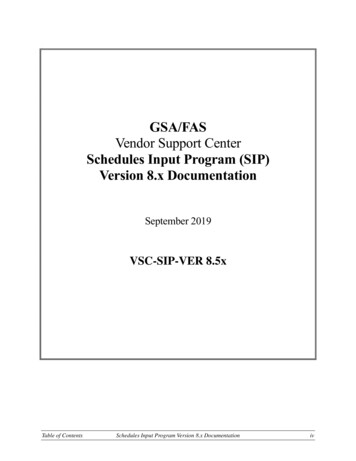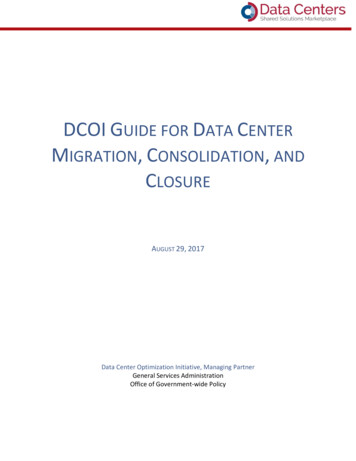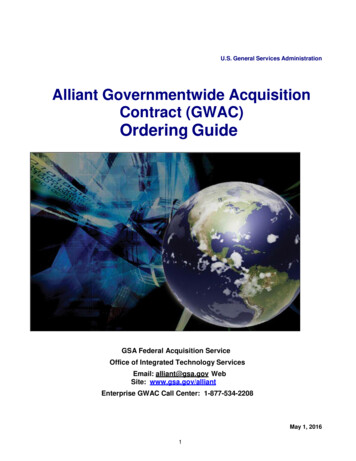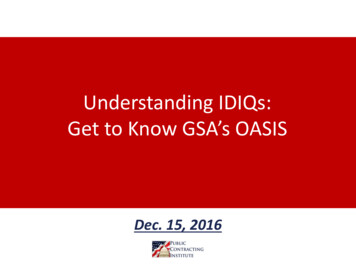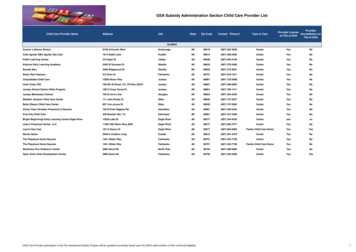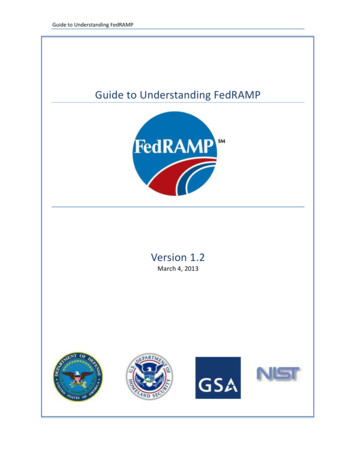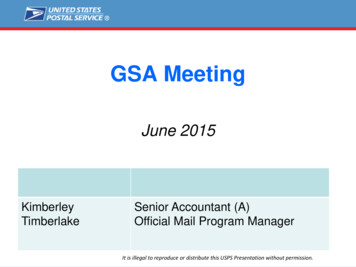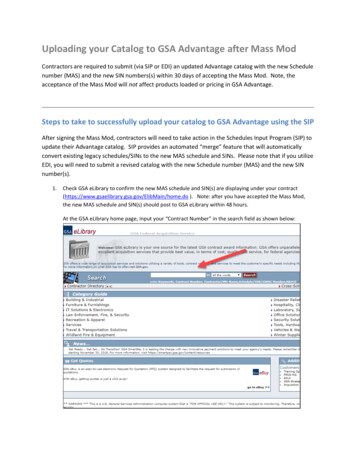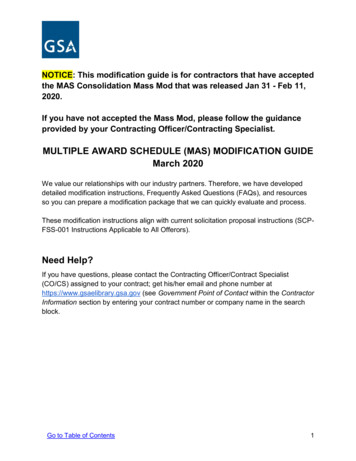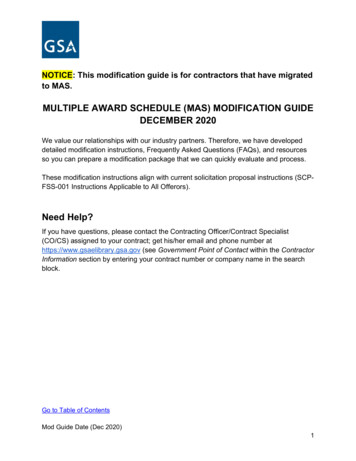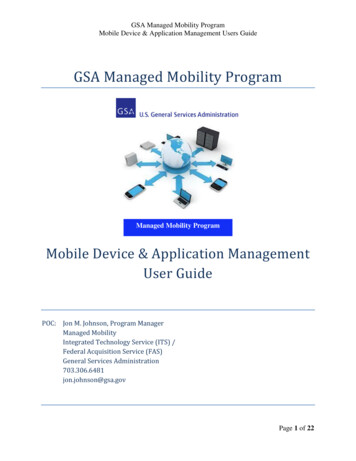
Transcription
GSA Managed Mobility ProgramMobile Device & Application Management Users GuideGSA Managed Mobility ProgramManaged Mobility ProgramMobile Device & Application ManagementUser GuidePOC: Jon M. Johnson, Program ManagerManaged MobilityIntegrated Technology Service (ITS) /Federal Acquisition Service (FAS)General Services Administration703.306.6481jon.johnson@gsa.govPage 1 of 22
GSA Managed Mobility ProgramMobile Device & Application Management Users Guide1What is the GSA Managed Mobility Program .31.1Why a Program and Not a Vehicle .31.2How the Program Will Evolve Over Time .32Potential Sources of Supply .42.1Mobility Management Solutions Table .42.2MDM/MAM Platforms . 52.3Integrators . Error! Bookmark not defined.2.4Pricing .53Assessment Methodology .63.1Technical Factors .63.2Compliance Factors .63.3Vehicle Factors .63.4Experience / Scalability Factors .74How to Acquire Solutions .84.1Primary Considerations . 84.1.1The Need to Go Mobile .84.1.2Mobility Decision Balancing .84.1.3Adapting Existing RFTC Requirements .94.1.4Solution / Marketplace Limitations . 114.1.5Should we buy multiple MDM solutions? . 114.2Availability on Existing Government-Wide Vehicles . 114.2.1IT Schedule 70. 124.2.2FSSI Wireless . 124.2.3Connections II . 134.2.4GWACS . 134.2.5Small Business Set-Asides, Directed 8(a) Set-Asides, and Other Government-Wide ProcurementVehicles 154.3Evaluation Considerations . 154.3.1FIPS 140-2 Cryptography Claims . 154.3.2Use of Validated Modules Such As OpenSSL . 164.3.3Cost Evaluation . 164.4Award Execution and Monitoring . 164.4.1FIPS Attestation . 165Post-Acquisition Activities . 185.1Feedback to the GSA Managed Mobility Program . 185.2Program Manager Contact Information . 186Acquisition Assistance . 196.1When to call for help? . 196.2Program Manager Contact Information . 19Page 2 of 22
GSA Managed Mobility ProgramMobile Device & Application Management Users Guide1 What is the GSA Managed Mobility ProgramThe GSA Managed Mobility Program assessed comprehensive cross-agency requirementsagainst Mobile Device Management, Mobile Application Management, and Mobility Life-Cycle(MDM/MAM/MLC) solutions that can be procured today via existing government-wide vehiclesand through procurement approaches available to every federal agency. The program creates andmaintains a list of potential sources of enterprise-class mobile management solutions that meetthe greatest governmental needs.1.1 Why a Program and Not a VehicleThe Managed Mobility Program is not a new acquisition vehicle. GSA Managed Mobilityleverages existing government-wide procurement vehicles and addresses the Digital GovernmentStrategy 5.5 action item for establishment of a government-wide program for Managed Mobilitysolutions. The MDM and MAM marketplace is undergoing rapid change, and governmentagency approaches to mobility are evolving. A new Managed Mobility-specific vehicle mayquickly become outdated due to market factors (shakeout, M&A, evolving technicalrequirements), and not be able to respond to changing needs and capabilities. This programprovides analysis, best practices, guidance and a central repository of information forgovernment-wide use.1.2 How the Program Will Evolve Over TimeThe GSA Managed Mobility Program will periodically reevaluate government mobilityrequirements and reassess marketplace solutions with consideration of government-wideacquisition capabilities. This will result in updates to the list of potential sources of supplyidentified for agency consideration. All updates to the program will be communicated throughthe web site www.gsa.gov/managedmobility, and updated Requests for Technical Capabilitieswill be released through FedBizOps at www.fbo.gov.GSA acknowledges that functional capabilities and requirements will evolve over time. Thisevolution can be captured through the existing programmatic structure; however we do anticipaterevisiting this programmatic methodology in the future.Certain requirements for mobility solutions will remain consistent: FISMA / NIST SP 800-53Compliance, FIPS 140-2 Validated Cryptography Modules, availability on existing governmentwide procurement vehicles, and demonstrated deployment of the technology.Page 3 of 22
GSA Managed Mobility ProgramMobile Device & Application Management Users Guide2 Potential Sources of SupplySolutions that have been determined to meet the greatest governmental needs against thefunctional requirements, have been deployed in the federal government, and are verified to beFIPS 140-2 capable are listed alphabetically. We expect that these potential sources of supplyshould meet the requirements we defined as required and most common across government.Vendor claims should be verified before acquisition. Agencies are free to procure solutions thatdo not appear below.2.1 Mobility Management Solutions emoSite*Partners/Resellers**Acquisition ApproachesCharles geIT Schedule 70Alliant GWACConnections II GWACGSA 8(a) Stars IISB Set AsidesMark PageAccenture Federal, Advantage Solution,CACI, Carahsoft, Delliotte Consulting,EC America, Fultron Inc., ImmixGroup,Karsun Solutions, Klouddata, OaklandConsulting, SAP Government Supportand Services, Inc., SAP Public Services,Software Information Resource Corp,Solers, TKC Global SolutionsSprint, , G4 Government-Solutions, Inc.,Ironbow, Shadow-Soft, Unisys,Telecommunication Systems Inc (TCS)CitrixFaisal Iqbal(301) 280-0797faisal.Iqbal@Citrix.comDemoPageIT Schedule 70, AlliantGWAC, Alliant SmallBusiness, 8(a) Stars II, SBSet AsidesGoodMolly al Technology Resources Inc.,Accelera Solutions Inc., ConvergenceTechnology Consulting, Force3, DMI,World Wide Technologies, CDW-G,Dell, Immix GroupAccenture, Carahsoft, Computer ScienceCorp (CSC), AT&T, HP EnterpriseServices, SAIC, GDIT, Verizon, TMobile, Dell, MicroTechMaaS360(Fiberlink)Jeff Ward434-242-3479jward@fiberlink.comDemoPageLevel 3 Communications, The WinvaleGroup, Patriot Technologies, A&TSystems, ICS Nett, Stratus Dynamics,Cherokee Nation Technologies, Unisys,InfoReliance, Sprint, GDITMobileIronSean Frazier (301) 693-9494sfrazier@mobileiron.comDemoPageAT&T, DMI, Parabal, Triad TechnologyPartnersAirwatchContactIT Schedule 70FSSI Wireless BPAAlliant GWACSB Set AsidesIT Schedule 70FSSI Wireless BPAConnections II GWACAlliant GWACGSA 8(a) Stars IISB Set AsidesIT Schedule 70FSSI Wireless BPAConnections II GWACAlliant GWACGSA 8(a) Stars IISB Set AsidesIT Schedule 70, FSSIWireless, Connections II,Alliant GWAC, SB SetAsidesSymantecDavid Hurley (571) 485-0086DemoAccenture, Booz Allen, Carasoft, CACI,IT Schedule 70,David Hurley@symantec.comPageComputer Science Corp (CSC), Dell,Connections II, AlliantHP Enterprise Services, LockheedGWAC, 8(a) Stars II, SBMartin, SAIC, ThunderCat, UnicomGovSet Asides* The demo portals are generic demonstrations. We encourage all ordering activities to contact the platform providers for personaldemonstrations to determine if they cover all functionality required by the agency or organization.** This may not be an exhaustive list of partners/resellers. For a more exhaustive list please ensure that you contact the platform provider fordetails.Page 4 of 22
GSA Managed Mobility ProgramMobile Device & Application Management Users GuideMobility Management Solutions(Integrators)ContactAcquisition ApproachesAccentureH. Jacob Brodyw: (571) 414-2674c: (571) 215-9676h.jacob.brody@accenturefederal.comIT Schedule 70, Alliant GWACAT&TRyan Lovew: (410) 782.2597c: (571).533.6959rl496j@att.comIT Schedule 70, FSSI Wireless, ConnectionsII, Alliant GWACCACIPhil Ardirew: (732) 460-7802c: (732) 963-5857pardire@caci.comIT Schedule 70, Alliant GWACCSCSiva Prakash Yarlagadda(571) 294-4667Syarlagadda3@csc.comIT Schedule 70, Alliant GWACHPDavid Cookw: (404) 648-2002c: (678) 549-9583davidc@hp.comIT Schedule 70, Alliant GWAC, ConnectionsII2.2 MDM/MAM PlatformsSolutions meeting the greatest government needs are mapped to their acquisition vehiclesaccessible either directly through the platform providers or through their partner/reselleragreements. The partners/resellers were identified by the platform providers themselves, and theability to procure solutions through a government-wide procurement vehicle will be dependenton not only the partner/reseller but also the terms and conditions of that underlying acquisitionvehicle.2.3 PricingMDM/MAM solution price points can vary depending on an agencies need. Typically basicMDM licensing is low cost and can be approximately 25 per device or user depending on thecompany’s pricing structure, but this varies when considering the FIPS-140 container elements.Each OEM solution provider above addresses containerization a little differently, and the type ofsecurity posture an agency has will impact the robustness of the containerized solution. Theprices can bring the total cost of the MDM solutions from the 50- 150 per device or user range.We suggest that you contact the vendors to receive more accurate pricing dependent on thefunctionality that you will require based on the security posture of your users.Page 5 of 22
GSA Managed Mobility ProgramMobile Device & Application Management Users Guide3 Assessment MethodologyThe GSA Managed Mobility Program developed requirements with a cross-governmental teamcomposed of CIOs, CISOs, and IT Mobility professionals to identify solutions that met thegreatest governmental needs, and could be acquired and deployed immediately through existinggovernment wide procurement vehicles.3.1 Technical FactorsGSA worked with a number of partner agencies (including DHS, DOJ, DOD, DISA, USDA, andothers) to identify functional, security and technical requirements that are common acrossgovernment. The RFTC constituted the 206 functional and security requirements, as well asoptional functionality, to which responses were assessed. Each response was assessed forconformance to these stated requirements by representatives of the cross-governmental team, andthe assessments were reviewed for consistently applied interpretations of the requirements andresponses before being considered valid. These validated assessments were then compared toone another to determine the market-based threshold for technical sufficiency, and to determinethe baseline to indicate those solutions meeting the greatest governmental need.3.2 Compliance FactorsTwo compliance factors were assessed separately: FIPS 140-2 Validation and FISMAAuthorization to Operate (ATO).FIPS 140-2 is the (National Institute of Standards and Technology) NIST standard that addressesthe use of cryptographic algorithms in IT systems. A solution was assessed as FIPS 140-2sufficient if it claimed FIPS 140-2 Validated cryptography was in use for all cryptographicoperations, AND that claim could be traced to a listed FIPS 140 Validation Certificate (directlyor indirectly), or to the NIST FIPS 140 “Modules in Process” list. Solutions not using FIPS 1402 Validated are less likely to receive an ATO from Agency leadership, and were excluded as apotential source of supply.The FISMA ATO factor examined the solution for evidence that either the entire solution, or thekey technical elements of it, had received an ATO for FISMA Moderate from a governmentagency in an actual deployment. This can be a time-consuming and costly exercise, so onlysolutions that provided evidence they had completed this process were included in the potentialsources of supply.3.3 Vehicle FactorsBecause the Managed Mobility Program was not creating a new acquisition vehicle, all solutionsthat met the other factors must be reachable through existing government-wide contract vehicles.The primary vehicles considered were Alliant, Connections II, and GSA IT Schedule 70, thoughPage 6 of 22
GSA Managed Mobility ProgramMobile Device & Application Management Users Guideother vehicles were considered where specified by respondents. Solutions that could not meetthis requirement were excluded from the potential sources of supply.Standalone MDM platforms can be purchased via Schedule 70 or Connections II, both of whichare GSA IDIQs. MDM, however, is rarely purchased without integration support due to the needto customize security, policy, and operational components. All GSA GWACs identified aspotential sources for procuring MDM solutions and solution sets require an integrationcomponent.3.4 Experience / Scalability FactorsGSA requires qualifying solutions to manage at least 10,000 devices, and offer additionalscalability beyond. While initial agency deployments may be lower, the anticipated demand formobile device usage will routinely exceed that threshold. GSA recognizes that newertechnologies may be naturally excluded by this threshold, but felt that this is a necessary tradeoff to support solutions that are immediately deployable. New technologies and solutions will beconsidered when the Managed Mobility Program periodically re-assesses both marketplacesolutions and government requirements.Solutions that demonstrated deployment experience of 10,000 or more devices in industry orgovernment were included in the potential sources of supply.Page 7 of 22
GSA Managed Mobility ProgramMobile Device & Application Management Users Guide4 How to Acquire SolutionsThe GSA Managed Mobility Program is intended to assist government agencies acquire mobilitymanagement solutions more quickly, at lower cost and with less risk.4.1 Primary ConsiderationsThe mobile mission and policy management are key considerations in MDM selection: What isthe agency trying to achieve with mobile, and how does the agency manage organizational policyto support that objective.4.1.1The Need to Go MobileDGS 9.1 includes an excellent guide to determining the extent of mobile device needs vs. desireswithin an agency. Some of the considerations are:How mobility will support the agency missionCostChange in security postureProductivity impact of increased user mobilityAgency obligations with increased mobility (contractual compensation requirementswhen contacting staff off-shift, policy and legal implications of BYOD, etc.)Please refer to the Mobile Computing Decision Framework in DGS 9.1, available atwww.gsa.gov/managedmobility.4.1.2Mobility Decision BalancingOnce the mobile capability objective has been defined with respect to the agency mission, thebalance of capabilities, economics and security follow. This section of the User Guide offers acursory overview. For the full process, please refer to the DGS 9.1 Mobile Computing DecisionFramework.The Decision Balance point is represented by the blue dot in the figure above. The closer theDecision Balance point is to a particular factor’s vertex, the more critical that factor is to mobilecomponent selection.Page 8 of 22
GSA Managed Mobility ProgramMobile Device & Application Management Users GuideThe three decision balancing factors are defined as follows:Capabilities: The closer a point is to the Capabilities vertex, the more important theability to support a wide range of applications and uses becomes. The Capabilities factorreflects the overall flexibility of the device in supporting a wide range of uses. Ingeneral, every mobile application that a mission uses requires increased device capability.Security: The closer a point is to the security vertex, the greater security must beaddressed in terms of compliance (policy), threat management, and data integrity. Thisfactor determines the importance of information security to the mission. Some missions,such as those dealing purely with publicly available information, do not require stron
2.3 Pricing MDM/MAM solution price points can vary depending on an agencies need. Typically basic MDM licensing is low cost and can be approximately 25 per device or user depending on the company’s pricing structure, but this varies when considering the FIPS-140 container elements.
